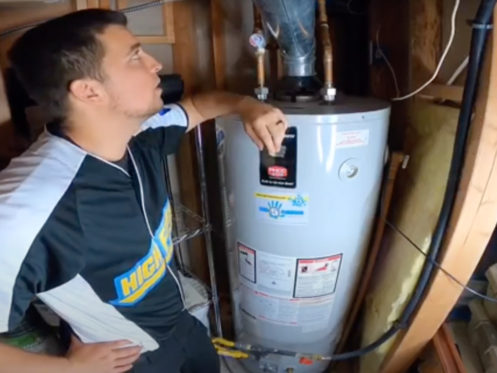We've stumbled upon the article on What Kind of Maintenance Do Water Heaters Need? listed below on the net and thought it made perfect sense to quickly share it with you over here.

Warm water is crucial for everyday comfort, whether it's for a revitalizing shower or cleaning meals. To ensure your warm water system runs effectively and lasts much longer, routine maintenance is essential. This article provides sensible tips and understandings on how to maintain your home's warm water system to stay clear of interruptions and expensive fixings.
Intro
Keeping your home's hot water system might seem complicated, yet with a couple of straightforward actions, you can ensure it runs smoothly for years to come. This guide covers whatever from understanding your warm water system to DIY maintenance pointers and understanding when to call specialist assistance.
Value of Keeping Your Warm Water System
Normal upkeep not only extends the life expectancy of your warm water system however likewise guarantees it runs efficiently. Neglecting upkeep can cause lowered efficiency, higher energy costs, and also premature failing of the system.
Indications Your Warm Water System Requirements Upkeep
Knowing when your hot water system requires attention can stop major problems. Look out for indicators such as irregular water temperature, weird noises from the heating system, or rusty water.
Recognizing Your Hot Water System
Before diving right into maintenance jobs, it's useful to recognize the standard parts of your hot water system. Normally, this includes the hot water heater itself, pipes, anode poles, and temperature controls.
Month-to-month Upkeep Tasks
Regular regular monthly checks ca
n help capture small issues before they intensify.
Purging the Water Heater
Flushing your hot water heater gets rid of sediment accumulation, enhancing performance and lengthening its life.
Monitoring and Replacing Anode Rods
Anode rods avoid rust inside the container. Evaluating and changing them when broken is essential.
Inspecting and Changing Temperature Settings
Adjusting the temperature setups makes sure optimum efficiency and safety.
DIY Tips for Maintenance
You can perform a number of maintenance jobs yourself to maintain your warm water system in top problem.
Looking for Leakages
Routinely inspect pipes and connections for leaks, as these can result in water damage and higher expenses.
Evaluating Pressure Relief Valves
Evaluating the pressure safety valve guarantees it operates appropriately and stops extreme pressure build-up.
Shielding Pipes
Insulating warm water pipelines decreases heat loss and can conserve energy.
When to Call a Professional
While DIY maintenance is beneficial, some concerns need professional proficiency.
Facility Concerns Needing Professional Aid
Instances include significant leakages, electrical problems, or if your hot water heater is constantly underperforming.
Routine Expert Maintenance Perks
Professional upkeep can include thorough examinations, tune-ups, and making sure compliance with safety and security requirements.
Conclusion
Routine maintenance of your home's warm water system is necessary for effectiveness, long life, and expense savings. By complying with these tips and recognizing when to seek specialist help, you can make certain a trustworthy supply of hot water without unanticipated disruptions.
How to Maintain an Instant Hot Water Heater
- Before tinkering with your hot water heater, make sure that it’s not powered on. You also have to turn off the main circuit breaker and shut off the main gas line to prevent accidents. Also turn off the water valves connected to your unit to prevent water from flowing into and out of the appliance.
- 2. When you’re done, you have to detach the purge valves’ caps. These look like the letter “T” and are situated on either side of the water valves. Doing so will release any pressure that has accumulated inside the valves while at the same time avoid hot water from shooting out and burning your skin.
- 3. When the purge valves’ caps are removed, you have to connect your hosing lines to the valves. Your unit should have come with three hoses but if it didn’t, you can purchase these things from any hardware or home repair shops. You can also get them from retail stores that sell water heating systems. Read the user’s manual and follow it to complete this task properly. When the hosing lines are connected, open the purge port’s valves.
- 4. You should never use harsh chemical cleaners or solutions when cleaning your unit. Make use of white vinegar instead. It should be undiluted and you’ll probably use about 2 gallons.
- 5. Now flush your water heater. This task should probably take about 40 minutes. We can’t give you specific directions for this because the procedure is carried out depending on the type, model and brand of your heater. With that being said, refer to the user’s manual.
- 6. When you’re done draining the unit, you have to turn off the purge port valves again. Remove the hosing lines that you earlier installed on each of the water valves. Put the valve caps (purge port) back in their respective places and be very careful so as not to damage the rubber discs that are found inside these caps.
- 7. Now that everything’s back in place, check your user’s manual again to find out how to reactivate your water heating system.
- 8. Once it is working, turn one of your hot water faucets on just to let air pass through the heater’s water supply pipes. Leave the tap on until water flows smoothly out of it.
https://www.orrplumbing.com/blog/2014/september/how-to-maintain-an-instant-hot-water-heater/

Do you really like more info about Tips For Maintaining Your Hot Water Heater? Create feedback down below. We'd be pleased to listen to your responses about this posting. Hoping to see you back again before long. Sharing is caring. Who knows, you might be helping someone out. I treasure your readership.
Find Out More
Comments on “How to Care for Your Home's Hot Water System EffectivelyCaring for Your Home's Hot Water System: Essential Tips”